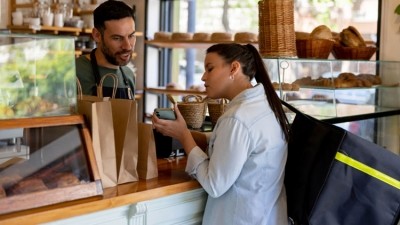Ask the Experts: payments

It’s difficult to think of an area of restaurant operations that’s more critical than taking payments, but it’s one that is often overlooked by operators. That’s not to say that restaurants are forgetting to deliver the bill at the end of the meal, rather that they could be doing so in a way that’s better for the guest and - potentially - for their own bottom line too.
Payments is a fast-moving and complex space. It literally pays to keep on top of it, whether that’s trying to get the best deals from the company or companies that handle transactions or smoothing the payment journey for the diner. With this in mind, we caught up with the payments experts at Dojo about the latest trends in the space, including the ongoing switch from cash to card, SoftPoS and how the pandemic has reshaped how diners settle up.
What should operators consider when choosing a payments system?
The key to creating a memorable experience for customers is ensuring that everything runs smoothly, we know that today, 56% of consumers are prioritising spending on experiences as opposed to things. So, how easy and quick it is for your customers to make a payment should be a key consideration. Hospitality in particular benefits from systems that help cut down process and admin as this helps restaurants and bars turn over more tables and serve more customers, giving them more time to focus on the overall experience. When it comes to card machines, portability, connectivity and ease of use are really crucial. Being able to access your payment transfers the next day should be a priority, particularly in the hospitality industry where quick access to cash for things like morning deliveries from suppliers is very useful. A card machine that can provide insights can also be incredibly useful, as these insights can help you to easily identify your busiest and quietest times, allowing you to better manage staff rotas.
Are there any pitfalls operators should be aware of, for example integration issues or excessive charges from payment gateways?
Some providers charge for next-day payment transfers - it’s important to keep an eye out for hidden charges related to drawdowns and early payments, as well as the fee per transaction. Some providers offer an “all in one” system, where a merchant replaces their EPOS system and entire payment system, others offer a more flexible approach where their card machines will seamlessly integrate with the current EPOS system. It is worth taking the time to consider which solution best suits your business’ needs.
Content provided by Square
How restaurants can navigate food inflation
Inflation is driving up costs in the hospitality industry by a steep 26% in the past two years, posing increased pressure on restaurateurs. The UK’s current food inflation rate is alarming, with prices for food and non-alcoholic beverages surging by 19.2% in the past year, and restaurants facing an average inflation rate of 10.4%. However, there are ways to navigate this challenging landscape:
1. Menu revamp: Leverage sales reports from your POS system to eliminate underperforming menu items, reducing unnecessary costs and labor associated with slow sellers. Promote popular items through marketing channels.
2. Supply chain optimisation: Utilise Square’s inventory management software to streamline supply chain operations, comparing vendors for the best deals. Explore local sources for fresh produce to potentially cut costs and enhance localised marketing.
3. Operational Efficiency: Invest in an all-in-one POS system like Square to simplify menu management, facilitate accurate orders via handheld devices, and enable mobile payments.
4. Smart Ingredient Choices: Consider cost-effective alternatives for expensive ingredients without compromising quality. Minor portion adjustments can also manage costs.
5. Minimise Waste: Leverage inventory management to avoid overstocking, properly store food, and monitor expiration dates to cut down on waste.
6. Hours Adjustment: Analyse sales data to optimise operating hours for peak profitability.
7. Tech for Engagement: Employ automated email marketing and loyalty programs to stay connected with customers, offering special deals and promotions.
8. Distinctive Offerings: Stand out by incorporating unique ingredients or local specialties to differentiate from competitors.
9. Expense Trimming: Identify unnecessary costs to improve cash flow without diminishing value.
10.Strategic Pricing: If price adjustments are needed, implement smaller, more frequent changes and monitor their effect on key metrics.
By leveraging strategic tactics and embracing technology, the industry can navigate these challenging times and potentially bolster profits, despite the ongoing inflation challenges. Find out what Square can do for your business here.
What is the industry standard when it comes to the percentage of each transaction that goes to payment companies?
The payments industry is vast and competitive. Among other things, providers offer different prices, terms of service, hardware, software and account management approaches. As a rule of thumb it is best to look at what is being offered holistically by a provider, compare, and decide which offering suits your business best.
How did the pandemic change the payments space?
Online shopping and grocery delivery grew exponentially throughout the pandemic, particularly during the various lockdowns. This hastened the rate of people choosing to shop online, with many retailers (particularly SMEs) adopting online checkouts to survive. Many bars, cafes and restaurants had to implement new ways to pay when lockdowns eased and were open to the public. Queuing, ordering and paying via apps became commonplace and venues that may not have accepted cards before had to pivot to allow for people’s preferences during this time.
Content provided by Dojo and Tevalis
At Dojo, we know how important providing a seamless dining experience is to our hospitality customers. Our technology can be a powerful tool in delivering on this and that’s why our focus is ensuring Dojo integrations work as hard as possible for our customers, including our integration with Tevalis. Together with Tevalis, our clients have access to insights, tools, and services, making it easier than ever to run their businesses. A spokesperson for Dirty Bones said: “Working with Tevalis and Dojo has many benefits. Their integrated solutions in our high turnover multi-sites are seamless and save us a huge amount of time.” Our integration helps our customers focus on what matters most to them. Their customers.
To find out more about what Dojo can do for your business here.
How has the payments space changed in the past year or so?
The pandemic has instilled a greater appreciation for experiences, prompting consumers to be more selective about where they invest their time and money. Ensuring a smooth dining experience is now of paramount importance. For bustling bars, offering QR codes to avoid queuing for drinks can enhance customer satisfaction. In fine dining, the focus lies on elevating the overall experience. Seamless integrations that enable staff to dedicate more time to diners play a pivotal role in achieving this goal.
How have changes in consumer behaviour impacted the payments and POS space?
Dojo’s Experience Economy report found that one in three of us are seeking memorable experiences regularly, and we are willing to pay up to 28% more to get it. Consumers are demanding more from business owners, powering a dramatic shift from commoditised goods and services to engaging experiences on the high street. Businesses with physical premises – primarily hospitality and retail – have a unique opportunity to build meaningful relationships with consumers by offering more: more focus on customer service, more personalisation, more meaningful interactions. And so now more than ever businesses need more time back in their day-to-day life in order to focus their efforts on giving customers an above and beyond experience worth paying for. By providing fast and reliable payment solutions, providers are now making this a reality for businesses, giving them the tools to turn transactions into meaningful relationships and become a part of the experience economy.
Is cash dead? What are the pros and cons of going cashless?
Cash isn’t dead, but more and more customers are switching to cards. There is a role for cash, and the best balance is for businesses to offer the right mix of payment options for their customers - and card payments are a popular and growing part of that. Card payment technology is now refined enough for the experience to be seamless and that’s what consumers want when paying.
Could the Amazon Fresh fully-contactless approach to payments ever work in the restaurant space?
The technology utilised in till-less grocery stores exists, so it is perfectly feasible that this could be applied to restaurants. However, as is often the case with cutting edge tech, the systems are expensive, at least in the first few years of launch. It does not take a huge leap of imagination to believe that we one day may see “walk in, walk out dining” in restaurants and across hospitality experiences more generally.
What new technology is coming down the track that could disrupt the payments space?
Software Point of Sale or SoftPoS is a rapidly growing area of technology that will carry huge benefits across hospitality. The technology allows merchants to accept card and digital wallet payments on a smartphone. In practical terms this means a restaurant could use business smartphones as primary, or back up method of taking payments when all the card machines are in use. Smartphones tend to be smaller than most card machines and can easily be kept in a pocket or apron which could make clearing a table and taking payment a more seamless experience for staff and diners.
































